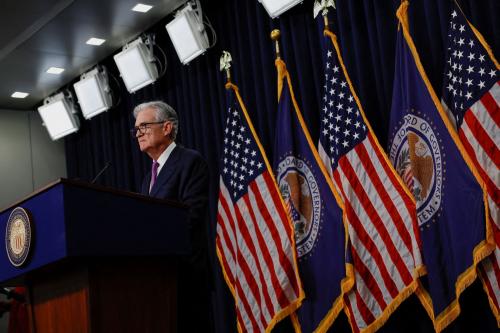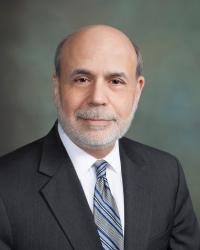I attended the Fed’s recent gathering in beautiful Jackson Hole, Wyoming—the first time I had been since the end of my term as Fed chairman. I enjoyed the opportunity to catch up with many friends and former colleagues.
As usual, the media were most focused on divining the next policy move of the Federal Open Market Committee (FOMC), but I found the more interesting (and ultimately more consequential) discussions were about the Fed’s longer-term policy framework, the theme of the conference. In this post I’ll report on one important debate: the question of the optimal long-run size of the Fed’s balance sheet. It seemed to me that the strongest arguments made at the conference supported a strategy of keeping the balance sheet large (though comparable to other major central banks), rather than shrinking it to its pre-crisis level as the FOMC currently plans to do.
The Fed’s balance sheet has roughly quintupled since the financial crisis, from about $900 billion in 2007 to about $4.5 trillion today. (See here for a useful overview of the main elements of the Fed’s pre-crisis and current balance sheets.) The increase mostly reflects the Fed’s large-scale asset purchases (quantitative easing), which the FOMC employed to reduce longer-term interest rates to help the economy recover from the Great Recession. Although the Fed stopped adding to its stock of financial assets in October 2014, it still holds about $2.5 trillion of U.S. Treasury securities and $1.7 trillion of government-guaranteed mortgage-backed securities.
Corresponding to the increase in Fed assets, there have also been substantial changes to the liability side of the balance sheet. Before the crisis, the Fed’s liabilities were mostly Federal Reserve notes (currency). Today, Federal Reserve notes are still a large item (about $1.4 trillion), but the largest category of Fed liabilities is bank reserves (deposits that commercial banks hold at the Fed). Bank reserves now total about $2.4 trillion, up from less than $20 billion in 2007. Ultimately, the source of the increase in reserves was the Fed’s asset purchases: The Fed financed its purchases of securities from the private sector effectively by writing checks on itself. Sellers of securities deposited those checks in the banking system, and banks in turn added those funds to their reserves.
Importantly, the large increase in the size of the balance sheet, and in the quantity of bank reserves in particular, changed fundamentally how the Fed affects its short-term policy interest rate, the federal funds rate, which is the rate at which banks borrow and lend reserves to each other. Prior to 2008, before the balance sheet expanded, the Fed managed the rate by changing the quantity of reserves in the system. By reducing the available supply of reserves, for example, the Fed could push up their price, the federal funds rate.
With the enormous quantity of reserves now available, however, small changes in the supply of reserves no longer suffice to control the funds rate. Today, the Fed influences it and other short-term rates primarily by varying the interest rate it pays banks on their reserves (known as IOER, or interest on excess reserves). This approach relies on the presumption that banks are unlikely to want to borrow or lend in private markets at an interest rate much different from what they can earn on the reserves they hold at the Fed. To further improve its control of interest rates, the Fed now also allows other private-sector institutional lenders, such as money market funds, to earn a fixed rate of interest on cash held for short periods with the Fed, through a program known as the overnight reverse repurchase (RRP) program. Currently the IOER is set at one-half percentage point and the interest rate on the RRP program is set at one-fourth percentage point. The use of the two rates has proven quite successful so far in keeping the federal funds rate in the FOMC’s target range of one-fourth to one-half percent.
It’s worth noting that the Fed’s current approach to setting interest rates is quite similar to that of other major central banks; the Fed’s pre-2008 system, in contrast, was idiosyncratic. Conformity with international practice is not necessarily a reason to prefer the Fed’s current tool set. But it is of some comfort to know that, rather than being new and untried, these methods have been in general use for a while and their implications for monetary control are well understood.
Because the size of the Fed’s balance sheet is closely tied to its methods for influencing short-term interest rates, the debate at Jackson Hole was about which “package” makes more sense: (1) the pre-2008 system that includes a relatively small balance sheet and the management of the funds rate through operations that vary the supply of bank reserves; or (2) the current system that includes a large balance sheet and the setting of the IOER and the interest rate on RRPs to establish the fed funds rate. The FOMC’s publicly announced strategy, reiterated by Janet Yellen in her opening speech, is to return over time to the pre-2008 system. The plan is to do this, at the appropriate time, by ending the reinvestment of maturing securities, thereby allowing the balance sheet to shrink “naturally,” and by phasing out the RRP program, so that non-banks will not be able to make deposits at the Fed.
Does this plan make sense? The answer is not clear cut, but based on the discussions at the conference, I’ll offer three arguments for changing course and keeping the balance sheet close to its current size in the long run, while managing interest rates through the payment of interest on bank reserves and a continued RRP program.[1]
First, in a paper presented at the conference, Robin Greenwood, Samuel Hanson, and (former Fed Board member) Jeremy Stein pointed out that a large Fed balance sheet could be a tool for enhancing financial stability. As the authors documented, there is a strong demand from the private sector for safe, liquid, short-term securities, as indicated by the fact that investors appear willing to accept much lower yields for very short-term government securities (e.g., one-week T-bills) than for government securities at longer terms, even say six months.[2] A variety of regulatory changes affecting banks, money-market funds, and other firms are likely to increase the demand for safe, liquid assets even further. How can this demand be met? One possibility is to leave it entirely to the private market to supply such assets. We have learned the hard way, though, that this strategy can lead to trouble, if the exceptionally low cost of very short-term borrowing incentivizes risky behavior. For example, before the financial crisis some firms financed long-term risky assets by issuing short-term commercial paper (so-called asset-backed commercial paper). When doubts arose about the quality of the underlying assets, however, this form of financing quickly disappeared, forcing the firms to sell off their assets in destabilizing “fire sales.” This dynamic was a major source of the crisis.
To reduce the incentives for such behavior, Greenwood et al. explained, the Fed could provide safe short-term assets (unlike the private-sector analogues, they would be truly safe!), in the form of bank reserves and especially through an expanded RRP program that would be open to a wide range of counterparties. Presumably the availability of such assets at the Fed would crowd out at least some risky private behavior by reducing the liquidity premium on very short-term financing.[3] To do that in a quantitatively meaningful way, however, the Fed would have to keep its balance sheet near its current size and continue (or expand) its RRP program.[4] Importantly, by using its balance sheet as the primary tool for enhancing financial stability, the Fed would gain more scope to focus on its inflation and employment objectives when setting interest rates.
Second, as suggested by Darrell Duffie and Arvind Krishnamurthy in another paper at the conference, a larger balance sheet that incorporates a robust RRP program could improve the transmission of monetary policy. Although the Fed is able to control the federal funds rate reasonably accurately, monetary policy can only have its desired economic effects to the extent that changes in the federal funds rate are reflected in broader financial conditions. However, for various reasons, banks may not fully pass on changes in the funds rate to depositors and borrowers. The links between bank borrowing and lending rates and key rates in securities markets can also be imperfect, due to market fragmentation and inadequate liquidity. Recent regulatory changes threaten to further impede monetary policy transmission.[5] Duffie and Krishnamurthy argue that the Fed could better ensure that its interest rate decisions are transmitted to money markets and financial markets generally by maintaining a sizable RRP program, through which nonbank institutions can deposit directly with the Fed and earn the RRP interest rate.[6] With the RRP program providing a direct link between the short-term policy rate and the securities markets, the Fed could rely less on the indirect transmission of monetary policy through the banking system.
A third possible motivation for the Fed to keep a large balance sheet in the long run relates to its role as a lender of last resort during financial crises. During a panic, depositors and other providers of short-term funding run on financial institutions, which can lead liquidity-short institutions to dump assets at any price (the “fire sales” problem mentioned above). By serving as a lender of last resort (i.e., by standing ready to lend cash against good assets), central banks can replace missing liquidity, avoid the fire sale dynamic, and calm the panic. However, for a central bank to successfully inject liquidity into the system, financial institutions have to be willing to borrow, which they may be reluctant to do if they fear this will identify them as particularly weak financially; this inhibition to borrowing is known as “stigma.” The Fed had to work hard to overcome stigma during the financial crisis of 2007-2009, and legislative changes since the crisis have probably make the Fed’s stigma problem worse.
It is striking that the stigma problem in several other jurisdictions, notably the eurozone, was less severe. Generally, European financial institutions did not avoid borrowing from the European Central Bank (ECB). A possible reason is that, before the crisis, European financial firms had both substantial deposits at the ECB (reserves) as well as large borrowings.[7] (In contrast, in the U.S. before the crisis, neither bank reserves nor borrowings from the central bank were significant.) Because European firms routinely engaged with the central bank in normal times, during the crisis they appeared able to use their reserves or adjust their level of central bank borrowings without signaling sharp changes in their financial conditions, thus mitigating stigma. In this respect, the ECB’s larger balance sheet coming into the crisis improved its ability to serve its critical function as lender of last resort.
I don’t want to overstate this argument. As always, there are tradeoffs: For example, in providing more backstop liquidity to the financial system, central banks may reduce the private sector’s incentives to manage its own liquidity effectively (the moral hazard problem).[8] The legal environment in the U.S. is also more restrictive than in Europe, in that the ECB can lend routinely to nonbank financial institutions but the Fed cannot. Still, there’s a good case to be made that maintaining significant baseline levels of bank reserves and bank borrowings from the Fed would reduce stigma and thus enhance the Fed’s ability to respond effectively to a panic.[9]
I’ve made three arguments for the Fed’s keeping a large balance sheet in the future, which would also imply controlling the funds rate by setting the IOER and the rate on RRPs, or through similar methods. What are the counterarguments? Why does the FOMC evidently want to return to the smaller, simpler balance sheet of the pre-crisis period?
One reason appears to be concerns that the RRP program could itself be destabilizing in a financial panic. In this view, in a period of financial stress, investors would be tempted to dump private short-term assets in favor of lending to the Fed. Phasing out the RRP program would avoid this possibility, it is argued.
While this issue deserves further consideration, some good responses came out of the conference. For example, as Jeremy Stein and others pointed out, the RRP program could be capped, limiting the amount of funds that could flow in during a stressed period. Keeping the RRP interest rate low even as private rates rise during a panic would also reduce the incentive for investors to flock to the Fed. To the extent that a larger balance sheet enhances financial stability and improves the Fed’s ability to serve as a lender of last resort, as I’ve discussed in this post, these risks would also be reduced.
A different argument against a large Fed balance sheet was made by my former Princeton colleague Chris Sims in a lunchtime talk on the interaction of monetary and fiscal policies. Chris pointed out that, with large asset holdings, central banks may face increased risk of financial losses, losses which ultimately can affect the government’s overall fiscal position. Fiscal losses in turn could trigger a legislative response, threatening the central bank’s policy independence. Chris advocated a “lean” balance sheet, minimizing the fiscal risks taken by the central bank.[10]
Certainly this point is important, and it seemed to resonate with the central banking audience. However, Jeremy Stein in his session again made what I thought was an effective counterargument, which was that the central bank’s financial risk depends more on the mix of assets held than on the overall quantity. He and his coauthor demonstrated in their paper that, if the Fed were to hold primarily assets that are safe and of limited duration (such as government debt of 2-3 years’ maturity), a permanently large balance sheet need not imply excessive fiscal risks.
Overall, I think the FOMC’s plan to return to a pre-2008 balance sheet and the associated operating framework needs more thought. The appropriate size and composition of the Fed’s balance sheet inevitably depends on a range of complex decisions about the management of monetary policy and the role of the central bank in preventing and responding to financial crises. We’ve learned a lot about both areas since the crisis, and some important arguments have emerged for keeping the balance sheet larger than in the past. Maybe this is one of those cases where you can’t go home again.
[1] In a talk at the IMF in spring 2015, I raised (in a preliminary way) the points (#1 and #2 below) that a large balance sheet would allow the Fed to provide markets with a safe, short-term asset and that it could improve monetary control.
[2] The authors report that, from 1983-2009, the yield on one-week T-bills averaged 0.72 percentage points less than the yields on six-month bills. Since the risks to both assets are negligible, almost all this difference presumably reflects the “moneyness” of the shortest-term assets.
[3] In other words, the Fed would be using its balance sheet to flatten the short end of the yield curve, thereby reducing the private sector’s incentive to engage in maturity transformation.
[4] An alternative public option would be for the Treasury to issue more short-term bills. However, that would involve frequent auctions of new bills, which (the authors argue) the Treasury sees as costly. The advantage of Fed-supplied assets is that they do not involve continuous auctions; instead, the Fed sets an interest rate and allows the demand for RRPs to vary with market conditions.
[5] For example, tougher limits on leverage make it less attractive for banks to participate in repo markets, reducing the liquidity of those markets and loosening the links between the repo rate, a critical short-term funding rate, and the funds rate.
[6] Additional arguments for why a large balance sheet could make monetary policy transmission more effective were provided at the conference by Ricardo Reis. Reis’s paper focused on the liability side of the Fed’s balance sheet and argued (among other points) that the ability to vary the interest rate paid on reserves according to the maturity of reserve holdings potentially provides the Fed with a new policy tool.
[7] For data on the ECB’s balance sheet, see here.
[8] For a discussion of tradeoffs associated with liquidity provision, see this paper at Jackson Hole by Ulrich Bindseil.
[9] To induce banks to borrow from the discount window during normal times, the Fed could consider auctioning discount window credit, as it did during the crisis.
[10] On similar principles, there is a good argument that central banks should minimize interventions in credit markets. I think it makes sense for the Fed ultimately to eliminate its holdings of mortgage-backed securities, for example. At the conference, Bindseil (see footnote 8) also recommended a “lean” balance sheet consistent with the “core” functions of the central bank, although he presented arguments on both sides of the issue.
Comments are now closed for this post.







Commentary
Should the Fed keep its balance sheet large?
September 2, 2016